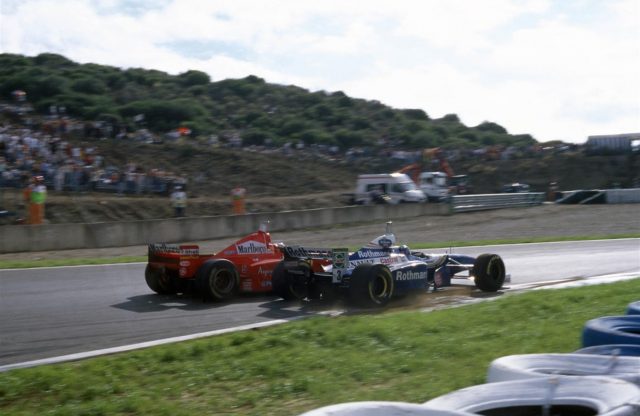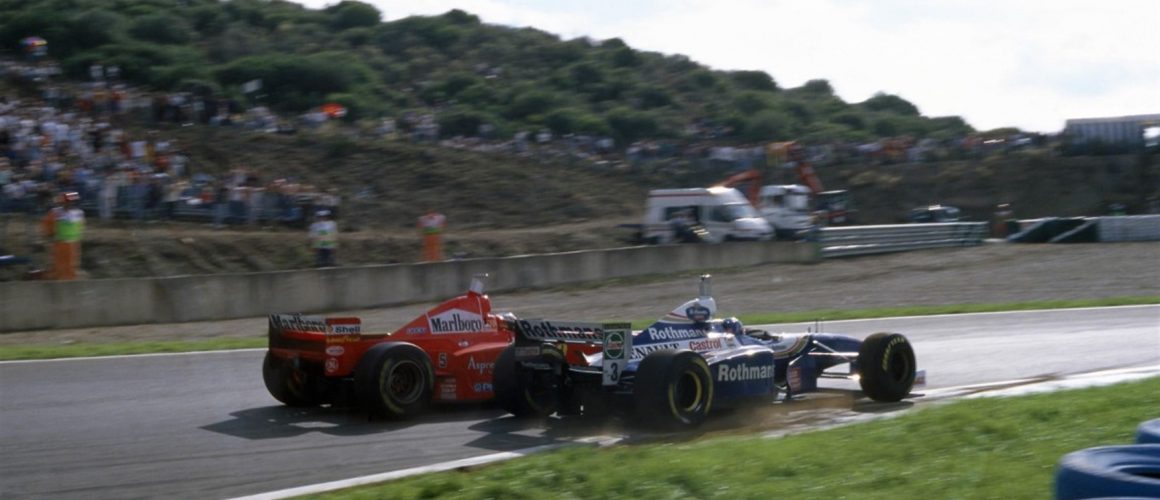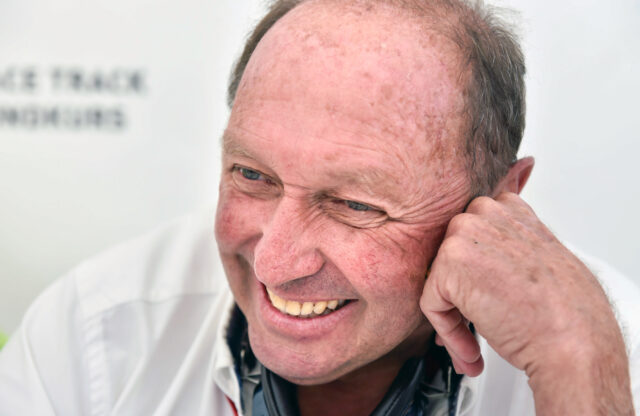Words: Elliott Hughes | Photography: Newspress
The high stakes world of Formula 1 is synonymous with controversy. From Brawn’s double-diffuser, to Red Bull’s flexi-wings and Ferrari’s recent engine controversy, there’s always some contentious issue causing the teams to bicker and keep the fans engaged. This season, the aftermath of Hamilton and Verstappen’s collision at Silverstone seems set to rumble on for a few weeks yet, so we thought we’d take a look back on some of F1’s most memorable controversies.
Crashgate, 2008
On lap 14 of the inaugural Singapore Grand Prix, Nelson Piquet Jr. crashed his Renault R28 into the wall on the outside of turn 17. At the time, the crash seemed innocuous enough; Piquet Jr. may have had the blood of a triple world champion coursing through his veins, but he was still a rookie.
The safety car was duly dispatched after Piquet had acquainted himself with the wall, which was great news for his double-world champion team mate, Fernando Alonso. Having made an early pitstop, Alonso was promoted to first place after his rivals scrambled into the pits under safety car conditions; Alonso never relinquished the lead and won the race.
With Piquet under threat of losing his drive in 2009, the truth came out and the incident was revealed by his father to be the machinations of Renault’s team principal Flavio Briatore and its engineering director Pat Symonds. Briatore and Symonds were both banned, then unbanned, Piquet went to NASCAR and then Formula E, and Alonso switched to Ferrari in 2010.
Spygate, 2007
The 2007 season’s thrilling three-way duel for the driver’s championship between Fernando Alonso, Lewis Hamilton and Kimi Räikkönen was embittered by one of the most sensational episodes of controversy the sport has ever witnessed.
The story begins in the unlikeliest of places: a photocopying shop near Woking in the UK. In June 2007, Trudy Coughlan, the wife of McLaren engineer Mike Coughlan, sauntered into Document Image Processing clutching a 780-page dossier filled with secret Ferrari technical information.
Trudy hadn’t banked on the fact that the clerk of the copying shop that day happened to be a die-hard Ferrari fan; he tipped off Maranello immediately. Coughlan acquired the Ferrari dossier through Nigel Stepney, a Ferrari engineer who was disillusioned with not being promoted after the exit of Ross Brawn in 2006.
Following the photocopier’s revelations, McLaren was found guilty of espionage, thrown out of the 2007 Constructors’ World Championship, and handed a record-breaking $100m fine. Renault F1 was also found guilty of possessing technical data belonging to McLaren, but no action was taken.
The story has a sad and tragic end after Stepney was killed in a traffic collision on the M20 motorway in May, 2014. Stepney’s death is widely believed to have been a suicide, although the coroner reported the cause of his death as ‘open’.
Schumacher and Villeneuve, 1997
It’s safe to say that the great Michael Schumacher became embroiled in more than his fair share of contentious incidents, and Jerez 1997 is arguably the largest black stain on his glittering career.
The ‘97 Drivers’ Championship had come down to the wire, and Schumacher was desperate to be crowned Ferrari’s first champion since Jody Scheckter in 1979.
Bizarrely, Jacques Villeneuve, Schumacher and Heinz-Harald Frentzen all set exactly the same qualifying times at Jerez, although Villeneuve started from pole on account of being the first of the three to complete his lap.
When the lights went out for Sunday’s title-decider, Schumacher overtook Villeneuve immediately. Despite this initial setback, Villeneuve responded brilliantly, applying immense pressure to Schumacher by looming large in his Ferrari’s mirrors for 47 laps.
Then, on lap 48, Villeneuve made his move. The Canadian lunged up the inside of Schumacher’s Ferrari at Dry Sack corner. With Villeneuve alongside, Schumacher turned in, smashing his Ferrari’s front wheel into the sidepod of Villeneuve’s Williams in an attempt to take him out of the race.
Schumacher’s devious plan backfired dramatically when he ended up in the gravel trap and Villeneuve continued, winning the title after crossing the line in his stricken Williams in third. Schumacher was lambasted by the world’s media after the incident, and thrown out of the 1997 standings, but allowed to keep his wins.
Tyrell, 1984
With the turbo revolution in full swing, the plucky little Tyrell outfit had to find a way to make its naturally aspirated Cosworth DFY-powered car competitive. The solution? Run the car below the 540kg kerbweight mandated by the regulations.
The seeds of Tyrell’s scheme had been sown in 1982, when several teams with naturally aspirated cars had the idea of running a water tank that was ostensibly for brake cooling. The tank was emptied during the race and then refilled before the car was weighed, bringing it back up to the legal weight limit.
FISA quickly closed this particular loophole by outlawing the topping up of fluids after the race. However, in 1984 the car’s water tank could still be refilled during pitstops
So, Tyrell decided to use the last pitstop of the race to fill up the car’s water tank with a mixture of water and lead shot, allowing the car to run underweight for a large proportion of the Grand Prix.
Tyrell’s plans were foiled when rivals reported spilled lead shot around the team’s pitbox. On further investigation, the water mixed with the lead shot was found to contain octane-boosting aromatics like toluene, which were being sprayed over the engine inlets for extra power.
When this was discovered, Tyrell was found guilty of both running an underweight car and illegally refuelling during races. It was thrown out of the 1984 standings, and Martin Brundle and Stefan Bellof were banned from the final three races of the season.
Benetton, 1994
The Williams FW14 and FW14B of 1992 and 1993 dominated F1 with advanced electronic systems including traction control, active suspension and anti-lock brakes. The FIA sought to ban these systems for the 1994 season while reintroducing refuelling during races.
After crashing out on the first lap of the Pacific Grand Prix, Ayrton Senna became suspicious of Benetton after hearing the sound its B194 was making on track. After Senna’s death at Imola, the FIA requested Benetton’s ECU data. The team obliged, but were fined for handing over the data late, arguing that Cosworth did not want the FIA to see its intellectual property.
The FIA’s analysis of Benetton’s engine data showed evidence the team had programmed an illegal launch-control system into the engine-management software, but no action was taken as there was no evidence that it was used during a Grand Prix.
Benetton’s rapid pitstops also raised eyebrows up and down the paddock. An investigation ensued after Jos Verstappen’s B194 was engulfed in flames in a pitlane fire during the 1994 German Grand Prix.
After the investigation, the team was found to be running its fuel pump without a filter to allow faster refuelling times. Again, Benetton evaded punishment when Intertechnique, the supplier of the fuel rigs, had allegedly told the teams to remove the filter.
Harry Schell, 1959
Harry Schell was the first American to compete in Formula 1, having lined up on the grid for the inaugural championship race in 1950. Schell was something of a mysterious character in the F1 paddock; born to American parents living in Europe, he was officially born in Paris in 1921, although many believed him to be over ten years older.
Age wasn’t the only thing Schell became known for cheating. Despite his obvious talent behind the wheel, putting on heroic drives for Maserati, Vanwall, Gordini, BRM and Cooper, Schell is best known for his antics at the 1959 US Grand Prix at the Sebring circuit.
Harry spotted an unmanned marshal’s post around the back of the circuit during qualifying and decided to exploit it by cutting the track. Schell slowed down in an attempt to avoid arousing suspicion but bested his previous qualifying time by a massive six seconds.
After qualifying, Schell apparently grinned as he was pushed onto the front row of the grid before the Grand Prix started; karma intervened when Schell’s clutch failed on the sixth lap. Tragically, Schell was killed just one year later during a non-championship event at Silverstone.
Senna and Prost, 1989 and 1990
The French professor vs the Brazilian phenom, Ayrton Senna vs Alain Prost is the emblematic rivalry of Formula 1. At first the relationship between the two legendary drivers seemed amicable, but that all began to change during the course of their fierce rivalry as McLaren teammates in 1989.
That year, Prost publicly stated he was growing weary of Senna’s aggressive, intimidatory driving on track. So, with the title on the line at the penultimate race of the season at Suzuka, Prost turned in on his teammate in an attempt to take them both out of the race and seal the world championship for himself.
After the contact, Senna limped back to the pits and had his wounded McLaren repaired. The Brazilian driver went on to win the race, before being controversially disqualified, handing Prost the title.
Senna was understandably incandescent, suspecting Frenchman FIA president Jean-Marie Balestre of favouring Prost. Ayrton vowed to take revenge, which he did at the very same circuit, one year later.
This time Prost and Senna were driving for Ferrari and McLaren respectively, and both had qualified on the front row, with Senna on pole. Senna was inexplicably forced to start from the dirty side of the grid, so when Prost’s Ferrari passed him at the start he kept his foot buried and put them both in turn one’s gravel trap, taking the title in the process.
James Hunt, 1976
The 1976 season is one of the sport’s most famous; the rivalry between Niki Lauda and James Hunt has since been immortalised through the Hollywood film Rush. The race before Niki Lauda’s accident at the Nürburgring was held on a sweltering summer’s day at Brands Hatch, and what happened there almost caused the fans to riot.
Hunt qualified in second place behind Lauda on pole, but dropped back after a slow getaway. In an effort to take the lead, Clay Regazzoni lunged up the inside of Lauda’s Ferrari into Paddock Hill, causing the two to collide and the race to be red-flagged.
The stewards decreed that a driver could restart the race after the red flag on the condition that he had completed the first lap and was in his original car. Ostensibly, this seemed fine as both Lauda and Hill had completed the first lap, but Hunt had taken a shortcut back to the pits and had technically not crossed the finish line.
Hunt was set to be disqualified and the British fans were furious, chanting and becoming increasingly restless and agitated. In the end, the stewards bowed to the pressure of the crowd and allowed Hunt to restart the race in his repaired McLaren.
Hunt went on to win the race, and McLaren’s rivals protested to the FIA. The protests were rejected and Hunt’s controversial victory stood.
Schumacher, 2006
It was Michael Schumacher’s final season at Ferrari and the German was engaged in an intense battle for the championship with a young Spanish driver named Fernando Alonso.
The controversy unravelled at the seventh round of the championship during qualifying at the Monaco Grand Prix. Schumacher knew as well as anybody that to win on the narrow streets of the principality, pole position is essential.
So, after setting a qualifying time good enough for pole position, Schumacher parked his Ferrari at Rascasse, bringing out the yellow flags and halting the progress of Alonso’s Renault.
Schumacher insisted that he had made a mistake and locked a wheel, but the FIA rejected his defence and swiftly demoted him to the back of the grid. Alonso went on to win the race, with Juan-Pablo Montoya’s McLaren and David Coulthard’s Red Bull completing the podium.
Vittorio Brambilla, 1975
Vittorio Brambilla was known as the ‘Monza Gorilla’ thanks to his extremely aggressive driving style. Driving for March, spectators were stunned as Brambilla took his only pole position and his team’s first in over five years during qualifying at the 1975 Swedish Grand Prix.
However, Brambilla’s race engineer Robin Herd later revealed that it wasn’t the Italian’s aggressive driving that secured him pole position that day. Herd explained that he was entrusted with Brambilla’s pitboard during the qualifying session and noticed that March’s pitbox happened to be adjacent with the timing beam across the circuit.
So, Herd decided to break the timing beam with his pitboard when Brambilla was still 50 yards from the finish line. Vittorio went on to lead the Grand Prix for 15 laps before a transmission failure forced him to retire.
If you liked this, then why not subscribe to Magneto magazine today?













